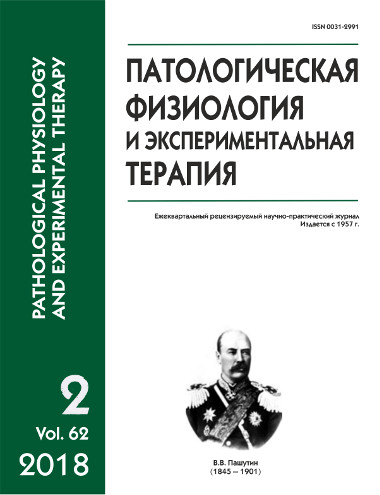Влияние мелатонина на клеточный состав печени крыс Wistar при алиментарном ожирении
DOI:
https://doi.org/10.25557/0031-2991.2018.02.107-112Ключевые слова:
экспериментальное алиментарное ожирение, мелатонин, коррекция, микроциркуляцияАннотация
Цель — морфофункциональная характеристика нарушений функции печени при алиментарном ожирении и их коррекция мелатонином. Методы. В эксперименте использовано 3 группы половозрелых (2 мес) крыс-самок Vistar с исходной массой 180–200 г. 1-я группа — контроль (интактные крысы); 2-я — группа «ожирение» (модель алиментарного ожирения воспроизводилась путем добавления (без ограничения) к стандартному лабораторному рациону в течение 3 мес пищевых жиров животного происхождения) и 3-я группа («ожирение + мелатонин») — животные с алиментарным ожирением, которым в течение 14 сут per os через желудочный зонд 1 раз в сут вводили водный раствор мелатонина (0,1 г на 100 г массы тела), животные жиры из рациона во время введения препарата не исключались. Крыс декапитировали под этаминаловым наркозом (40 мг на кг), извлекали печень для морфометрического и светооптического исследования (микроскоп LEICA DM 750, камера LEICA ICC 50 HD). Патогистологические препараты готовили по общепринятой методике. Исследование препаратов печени проводили при увеличении × 1000 на срезах толщиной 5 мкм, окрашенных гематоксилином Майера и эозином, сульфатом нильского голубого. Для морфометрического анализа использовали метод наложения точечных морфометрических сеток (сетка 256 точек). Определяли относительную площадь сети синусоидов, ядер и цитоплазмы гепатоцитов, численную плотность синусоидных клеток и гепатоцитов и двуядерных паренхиматозных клеток; рассчитывали ядерно-цитоплазматическое соотношение, отношение численной плотности синусоидных клеток к численной плотности всех гепатоцитов, вычисляли долю диплокариоцитов от общего числа гепатоцитов, рассчитывали коэффициент Vizotto — отношение площади сети синусоидов к площади всех гепатоцитов. Результаты. Введение мелатонина нивелировало признаки нарушения кровообращения, крово- и лимфотока. Отмечалась сохранность сосудов портального тракта, восстановление архитектоники центральных вен. Большинство участков гемо- и лимфообращения не имело признаков грубых нарушений. Заключение. Ожирение приводит к значительным нарушениям в системе кровообращения и лимфотока в печени, развитию жировой дистрофии. Введение таким животным гормона эпифиза мелатонина способствует усилению репаративных процессов в печени, нормализации микроциркуляторных процессов, восстановлению микроструктурной и функциональной организации органа.Загрузки
Опубликован
2018-06-01
Выпуск
Раздел
Оригинальные исследования
Как цитировать
[1]
2018. Влияние мелатонина на клеточный состав печени крыс Wistar при алиментарном ожирении. Патологическая физиология и экспериментальная терапия. 62, 2 (Jun. 2018), 107–112. DOI:https://doi.org/10.25557/0031-2991.2018.02.107-112.













